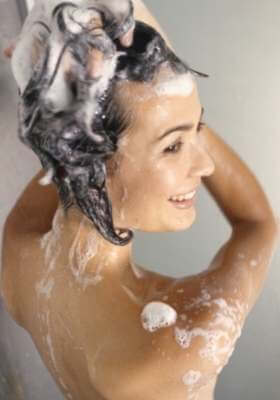Who doesn’t like a good coconut hair oil treatment now and then? They’re an excellent way to hydrate, strengthen, and protect your hair.
While most people know how to apply coconut hair oil, many have trouble rinsing it out. There is a proper way to remove coconut oil from your strands, and we’re here to show you how. You’ll learn how to wash hair after applying coconut oil in the sections below.
Table of Contents
How long to keep Coconut Oil?
Apply and massage coconut hair oil into your scalp and hair for two to three hours before washing your hair. Most shampoos contain harsh substances that can strip your hair strands of important oils. Oiling your hair before washing it can help you avoid this problem. It takes time for the oil to reach your scalp, so leave it on for a bit. Allow it to sink into your follicles, nourishing them from the inside out. In order to nourish your hair strands and give them that healthy, bouncy bounce, you should leave it on for at least an hour.
If you leave it overnight or for more than 3 hours, you’ll wake up with greasy, sticky hair. When your hair gets excessively oily, it accumulates debris and interacts with the natural oil on your scalp. As a result, it’s critical to keep the oil on for a while but not too long.
To know more check the in-depth article on How Long do I Leave Coconut Oil In My Hair?
How much Coconut Oil should you apply?
The amount of oil required is determined by the length and purpose of your hair. Depending on your hair density and texture, apply a few drops or one to three palmfuls of coconut oil to your scalp gently. Start with your scalp, then gently massage oil into your mid-lengths and ends with your hands to provide much-needed moisture, especially if you color or chemically treat your hair. There’s no need to apply extra coconut oil after you’ve applied a generous amount. Remember that using too much of it demands using too much shampoo as well. Hair might lose its natural, protective oils and moisture as a result of this. As a result, your hair will dry out and appear much more damaged and duller than before.
Do you know that if not done properly, oiling your hair with coconut oil can actually do more harm than good? Check this detailed article on How to Apply Coconut Oil to Hair in 6 Steps
Which shampoo to use?

When it comes to removing the coconut oil from your hair, any wash will not suffice. Again, your hair type and texture will determine which one is best for you.
Dry Hair
If you have dry hair, the most important thing you can do is moisturize it. It’s difficult to keep dry hair under control. It’s also a damaged hair symptom. It might become brittle and breakable over time. To keep its texture, it does not absorb moisture. Dry, coarse hair tangles easily, necessitating the use of gentle, nourishing shampoos at every stage of hair care.
Always remember that creamy and moisturizing shampoos are best for dry hair. This hair type is prone to frizz, therefore using shampoos that contain hydrating elements can assist to condition the hair and prevent frizz. Shampoos for dry hair should be followed up with a conditioner. After washing your hair, use a nourishing conditioner with smoothing characteristics to help seal in moisture and reduce frizz.
Colored Hair
Because coloured hair is subjected to chemical treatments, it requires specific attention. On coloured hair, not all normal shampoos are effective. So, to be on the safe side, use shampoos made specifically for coloured hair! Coloured hair needs more hydration, so look for a shampoo that is specifically designed for it. Hair that has been coloured should only be washed every few days. Otherwise, it may swiftly fade. Colour-safe shampoos are also gentler than traditional shampoos.
If you have colour-treated hair, search for shampoos that are sulfate-free. Sulfates hasten the fading of your hair colour. Because colour-safe shampoos have a lower pH, they can’t easily open the hair cuticle. Some colour-treated shampoos contain SPF, which helps to protect the hair from sun damage and colour fading. Look for shampoos that contain nutrients like amino acids and soy extracts, which aid in the preservation of hair colour.
Oily Hair
Sebum produced in excess can make your hair oily and filthy. Oily hair requires frequent washing to maintain a beautiful gloss and avoid greasiness. You will inevitably lose hair if your shampoo is overly harsh. Because oily hair causes excessive oil production on the scalp, hydrating, moisturising, and creamy formulations that add extra moisture and grease to the scalp should be avoided. In shampoos, look for balancing and strengthening formulas.
Additionally, seek shampoos that contain sulphates, which help eliminate oils and debris, and salicylic acid, which can break down excess sebum.
Curly Hair
If you have naturally curly hair, you can’t treat it the same way everyone else’s. Choose a shampoo with a high protein content or one that is specifically formulated for your hair type to promote deep root conditioning and moisturization. Curly hair is drier due to its texture, and it is exacerbated by high humidity. Use an ultra-moisturizing shampoo to help minimise frizz and dryness while not weighing your hair down if your curls are frizzy.
Fine Hair
Because fine hair is inherently smooth, it takes less time to dry. However, it has a lower volume and a higher tendency to turn oily. If you have fine hair, stay away from creamy shampoos and instead opt for volumizing, non-creamy shampoos.
The lightest shampoos are volumizing shampoos, which can add body to your hair and lift the cuticles. They contain substances such as hydrolyzed wheat protein, which helps to increase the width of the hair shaft, making your hair bulkier. Additionally, avoid shampoos that include silicones, as they might weigh down your delicate hair strands.

How to wash?
It’s time to start using the shampoo you’ve chosen for your hair type. This is where we go through how to wash your hair after applying hair oil in depth. Remember that coconut oil is heavy, so use warm water instead of cold, as cold water may cause some oils to clump on your stands. That’s something you shouldn’t have to deal with. To get rid of the oil, you may need to shampoo a few times, but be careful not to overdo your shampoo. This can reverse the benefits of the hair oil treatment.
A hair rinse might help you get rid of excess oil in a gentle way. We’re here to remind you that the type of rinse you use will be determined by your hair and oil. You can use a variety of rinses to remove extra oil, including lemon, apple cider vinegar, and others. It’s entirely up to you!
Use conditioner
Finishing with conditioner is the final step in washing out your hair oil. Your strands will be ready for increased moisture once you’ve used the right shampoo and rinse. The best part about the last step is that you can use almost any conditioner you currently own. You’re good to go as long as it gives your tresses the nutrition they require.

Creative, versatile, and passionate about her craft, Rupa Das is a well-recognized name in the world of fashion and makeup! This is a woman who has been in the fashion and makeup industry for 24 years and is still one of the leading international makeup artist in the circuit! She has worked in big brands like Lakme, Green Trends, Colors and transitioned to become a Beauty (Hair & Skin) Trainer.